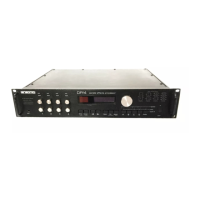Section 5 — Storage
ENSONIQ DP/4+ Reference Manual 11
Using the Preset Parameter Worksheet
There is another method for saving presets. You can manually record all the parameters of your
created preset by using the Preset Parameter Worksheet (or a photo copy) located at the end of
this section and at the end of the manual. Although this method is time-consuming and
laborious, it is still an accurate method for saving presets if you do not have access to a System
Exclusive data recorder, or if you want to use one of your own custom effect creations at another
studio without bringing your own DP/4+.
Presets consist of a combination of algorithm parameters and config parameters. Although each
type of config and algorithm has a different set of parameters, you can still use the worksheet
because it is based on the parameter number. You can find the parameter numbers by looking at
the LED numeric display in Edit mode on your DP/4+. For example, in the Hall Reverb
algorithm, the LF Decay Time is parameter 05:
Hall
LF DecayTime=+06
In our example, the value for the LF Decay Time (parameter 05) is set at +06. This would be
written on the Worksheet like this:
07 -
01 - Mix
02 - Volume
03 -
04 -
06 -
Unit A Algorithm:
05 -
To find the parameter numbers for your config, press the {EDIT} button, then the {CONFIG}
button. Use the {<} and {>} buttons to scroll through and record the edited parameters.
To find the parameter numbers for your algorithms, press {EDIT}, then each Unit button ({A},
{B}, {C}, and/or {D}) that relates to your preset (a 2 Unit preset only uses two algorithms and
only requires two columns). Use the {<} and {>} buttons to scroll through and record the edited
parameters.
Note: Many of the algorithms and configs do not require all of the spaces provided
on the Preset Parameter Worksheet. You should leave these spaces blank.

